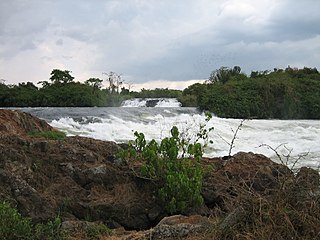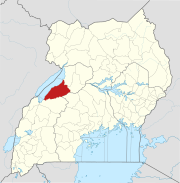Burning of renewable resources provides approximately 90 percent of the energy in Uganda, though the government is attempting to become energy self-sufficient. While much of the hydroelectric potential of the country is untapped, the government decision to expedite the creation of domestic petroleum capacity coupled with the discovery of large petroleum reserves holds the promise of a significant change in Uganda's status as an energy-importing country.

The Ministry of Energy and Mineral Development, also Ministry of Energy, Oil and Mineral Development is one of the governmental bodies of Uganda. The ministry has the function of developing and implementing policies related to electricity, minerals, petroleum and petroleum products. The ministry is part of the national cabinet and is headed by a cabinet minister. The current Cabinet Minister of Energy is Engineer Irene Nafuna Muloni.

The Bujagali Power Station is a hydroelectric power station across the Victoria Nile that harnesses the energy of its namesake – the Bujagali Falls – in Uganda. Construction began in 2007 and concluded in 2012. It was officially inaugurated on 8 October 2012 by Ugandan President Yoweri Museveni and Aga Khan IV in the presence of African politicians and investors.
Tororo Thermal Power Station is a 89 MW (119,000 hp) heavy fuel oil-fired thermal power plant located in the town of Tororo in Tororo District in the Eastern Region of Uganda.

The Karuma Hydroelectric Power Station is a 600 MW hydroelectric power project under construction in Uganda. When completed, it will be the largest power-generating installation in the country.

Isimba Hydroelectric Power Station is a 183.2 megawatts (245,700 hp) hydroelectric power station commissioned on 21 March 2019 in Uganda. Construction of this dam began in April 2015 and was completed in January 2019. Commercial operations began on 21 March 2019.

The Muzizi Power Station is a proposed 45 megawatts (60,000 hp) hydroelectric power project in Uganda. The project, which has been planned for several years, has received a funding commitment from KfW and the French Development Agency.

Ayago Hydroelectric Power Station, also Ayago Power Station, is a planned 600 megawatts (800,000 hp) hydroelectric power project to be constructed in Uganda.
Waki Power Station is a proposed 5 megawatts (6,700 hp) mini hydroelectric power station in Uganda, the third-largest economy in the East African Community.

Kikagati Hydroelectric Power Station, also referred to as Kikagati Power Station, is a 16 MW (21,000 hp) hydroelectric power station, under construction in Uganda.

Nyagak III Power Station is a 6.6 megawatts (8,900 hp) proposed mini hydroelectric power project in Uganda, the third-largest economy in the East African Community.

Rwimi Hydroelectric Power Station, also Rwimi Power Station, is an operational 5.54 megawatts (7,430 hp) hydroelectric power station in the Western Region of Uganda.
Tororo Solar Power Station, also Tororo Solar North Power Station, is a 10 megawatts (13,000 hp) solar power plant in Uganda, the third-largest economy in the East African Community.
The Hoima–Kampala Petroleum Products Pipeline (HKPPP) is a proposed pipeline to transport refined crude oil products from the Uganda Oil Refinery in Hoima to a distribution terminal near Buloba in Wakiso District, approximately 28 kilometres (17 mi), by road, west of Kampala's central business district.
The Uganda Electricity Transmission Company Limited (UETCL) is a parastatal company whose primary purpose is to make bulk electricity purchases and transmit the electricity along high voltage wires to local and foreign distribution points. UETCL is the sole authorized national bulk energy purchaser and the sole authorized electricity importer and exporter in Uganda.
The Nkenda–Fort Portal–Hoima High Voltage Power Line is a high voltage electricity power line, in operation, connecting the high voltage substation at Nkenda, Kasese District, to another high voltage substation at Kabaale, Buseruka sub-county, Hoima District, all in the Western Region of Uganda.
The Tororo–Opuyo–Lira High Voltage Power Line is a high voltage electricity power line, connecting the high voltage substation at Tororo, to another high voltage substation at Lira, in Uganda.
The Masaka–Mutukula–Mwanza High Voltage Power Line is a proposed high voltage electricity power line, connecting the high voltage substation at Masaka, in Masaka District, in the Central Region of Uganda, to another high voltage substation at Mwanza, in Mwanza Region, in the Republic of Tanzania.









